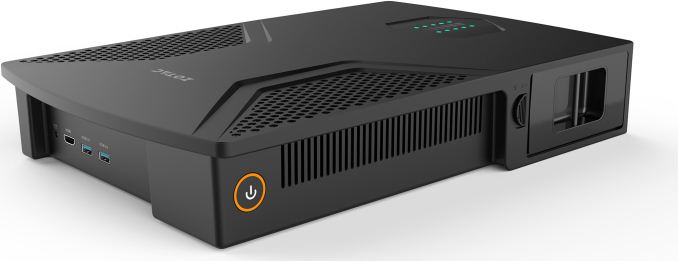ZOTAC Announces VR GO Backpack PC with GeForce GTX 1070
by Anton Shilov on November 2, 2016 12:01 PM EST
ZOTAC this week has formally introduced its VR GO backpack PC designed for virtual reality enthusiasts. The system is equipped with NVIDIA’s GeForce GTX 1070 graphics, a quad-core CPU from Intel, rich I/O capabilities and a hot-swappable battery. Despite its positioning, the VR GO can be used like a normal desktop computer, which differentiates it from early prototypes of wearable VR PCs from other makers.
ZOTAC is mostly known for its graphics cards and high-performance small form-factor PCs, but not wearable systems (which are not that uncommon: industrial- and even space-grade wearable PCs have existed for years). To develop its VR GO computer, the company had to use experience it obtained from building SFF systems for gamers as well as to find ways to minimize weight and to ensure that the design can handle harsh treatment during gaming sessions. Basically, ZOTAC had to fix everything tightly inside the box while ensuring appropriate cooling and proper position of the I/O ports.
To make it convenient to connect a VR headset to the VR GO, one side of the device has the appropriate ports. The single side has one HDMI output, two USB 3.0 ports and one power connector on top of it. Such positioning greatly simplifies cable management and makes VR gaming with a PC on your back a little more comfortable. The system also comes with a removable battery pack that enables autonomous operation for (waiting on offical numbers) hours.
While virtual reality is considered as an important milestone for gaming, it hardly makes sense to develop a PC only for VR, which is why ZOTAC’s VR GO is a powerful PC in general and can be used like a desktop computer too. It has three additional USB 3.0/3.1 Type-A connectors, an SD card reader, four additional display outputs (two HDMI, two DP), two GbE ports as well as two 3.5 mm audio jacks.
Inside the ZOTAC VR GO there is a custom motherboard in a proprietary form-factor carrying an Intel Core i7 CPU, two DDR4 SO-DIMMs, an M.2 SSD (PCIe 3.0 x4), an 802.11ac Wi-Fi module and NVIDIA’s GeForce GTX 1070 MXM module. To cool down the CPU and the GPU (a total TDP of 150 W), ZOTAC uses a proprietary low-profile air cooling system but has not disclosed details. At this point, we do not know whether the manufacturer reinforced the design of its cooler's backplate somehow, but this is a logical thing to expect. To expand the storage capacity of the system, ZOTAC also added one bay for a SATA-based 2.5" storage device (either HDD, which might be affected by rapid movement, or a high capacity TLC SSD).
ZOTAC’s VR GO system is not the first backpack-type PC developed by the company. At Computex 2016 the hardware manufacturer already demonstrated a wearable system, but that was largely a prototype and still in the early design stage. By contrast, the VR GO looks like a commercial product.
ZOTAC does not specify exact availability timeframe for its VR GO backpack PC other than Q4 2016 as well as its estimated price. We expect to see it at CES in early January for sure.
Related Reading
- HP and MSI Demonstrate Backpack PCs for VR Gaming
- ZOTAC ZBOX MAGNUS EN980 SFF PC Review - An Innovative VR-Ready Gaming Powerhouse
- ZOTAC ZBOX CI523 nano Fanless Skylake-U mini-PC Review
Source: ZOTAC















30 Comments
View All Comments
Lord of the Bored - Thursday, November 3, 2016 - link
Possibly even DOZENS!
ImSpartacus - Friday, November 4, 2016 - link
The article states that the cpu and gpu collectively put off 150W and the cooling is built to handle it.So I think the battery can provide more than 100W of power.
JoeyJoJo123 - Wednesday, November 2, 2016 - link
Pretty sweet! I'm sure it'd cost an arm and a leg, but VR peripherals are already in that territory anyways.Cygni - Wednesday, November 2, 2016 - link
The future is just terrible.BrokenCrayons - Wednesday, November 2, 2016 - link
What makes you say that?Cygni - Wednesday, November 2, 2016 - link
This.Rocket321 - Wednesday, November 2, 2016 - link
As a form factor this looks like a really nice living room gaming PC / steam machine.PsychoPif - Thursday, November 3, 2016 - link
I agree, if you remove the strapping, it can easily compete with a console on looks.MattMe - Wednesday, November 2, 2016 - link
Given that you need to be in a room with the lighthouses, or whatever Oculus call their equivalent, I'm not sure if a wearable VR PC is even necessary, is it?rhysiam - Wednesday, November 2, 2016 - link
My understanding is that the goal of these units is not portable VR gaming. You could do that with a mini ITX rig which you can stuff into any old backpack to move around. Rather it is about removing the cables that tether you to the computer and invariably get tangled up at your feet.That however, raises a big question. For the Rift you'd still need a usb cable running from the backpack to the sensor, which totally defeats the purpose. And for the Vive you'd need the tether cable to the link box (which needs power). I'm guessing the "power connector" mentioned in the article could be used for a Vive link box, which would do the trick, but there's nowhere obvious (that I can see) to physically secure a link box to the backpack.
So... for Rift this seems entirely pointless because you're still tethered via a USB cable (why not ditch the backpack and tether yourself to a computer instead?) And for the Vive you have to retro-rig some sort of link box mount. Or am I missing something here?